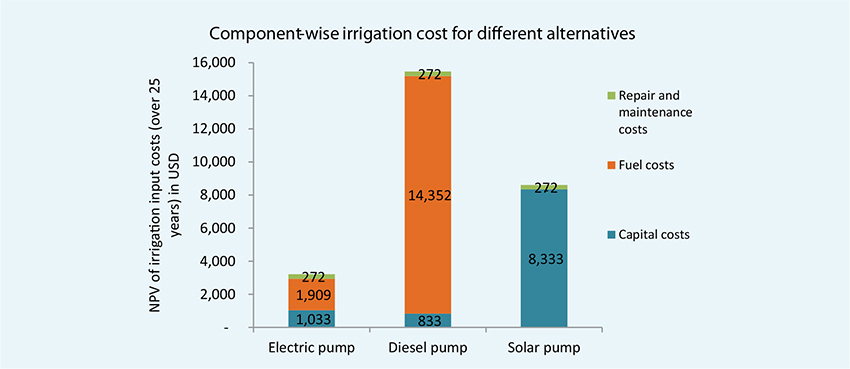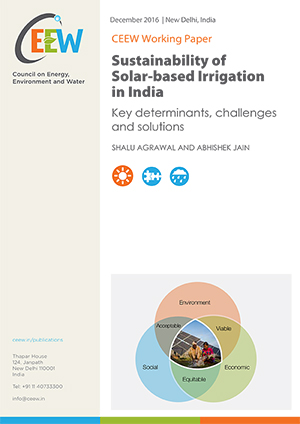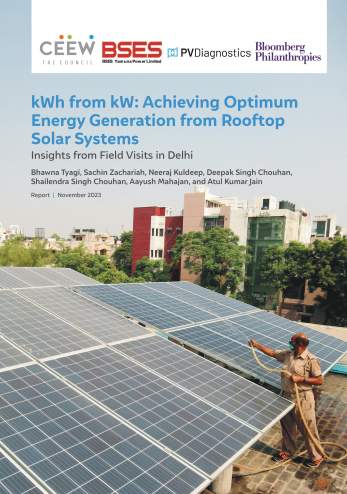Paper
Sustainability of Solar-based Irrigation in India
Key Determinants, Challenges, and Solutions
Shalu Agrawal, Abhishek Jain
December 2016 | Energy Transitions, Sustainable Livelihoods
Suggested Citation: Agrawal, Shalu and Abhishek Jain. 2016. Sustainability of Solar-based Irrigation in India: Key Determinants, Challenges, and Solutions. New Delhi: Council on Energy, Environment and Water.
Overview
Millions of farmers in India continue to lack access to irrigation and are predominantly rain dependant, particularly in the eastern region of the country. This has led solar irrigation pumps (SIPs) or solar-powered irrigation systems (SPIS) to emerge as an alternative to conventional irrigation solutions.
This working paper discusses the key determinants of the economic, environmental, and social sustainability of solar-powered irrigation systems. Drawing from the best practices and experiences in South Asia and Sub-Saharan Africa, this paper highlights key recommendations on ways to incorporate sustainability concerns in policies and programs for deployment of SIPs.
Key findings
Major determinants of economic sustainability
- Irrigation water requirement: Crops with high water requirement require high capacity of SPIS and climatic factors such as temperature, humidity, sunshine, and windspeed influence the crop water need.
- Solar irradiance: A majority of India’s land is endowed with annual solar radiation of more than 5 kWh/m2/day, favouring solar-based irrigation. However, SPIS might not work for days at length during winter months which might adversely impact crop productivity in absence of adequate backup for irrigation.
- Depth or distance from the water source: Regions experiencing rapid groundwater decline can have an adverse effect on the economic sustainability of solar-based irrigation.
- Quality of the system: Measures to regulate the quality of SPIS entering the market would be critical to maintain economic sustainability of SPIS, while keeping the O&M costs low. Further, measures such as awareness generation about quality assurance, post deployment monitoring of SPIS, and a strong grievance redressal system would be crucial to protect farmers against poor quality products.
- Purchasing capacity of farmers: State-backed financial support schemes provide a combination of debt, equity, and grants to facilitate uptake of solar pumps. Innovative financial products could help bring SPIS within the purchasing capacity of a majority of farmers.
- Cost of alternative solutions: SPIS would be more economically attractive than diesel pumps, but highly uneconomical compared to grid powered pumps, due to the heavy state subsidies on both agricultural electricity connections as well as consumption.
From a life cycle perspective, solar-based irrigation is more cost-effective than diesel powered irrigation.

Source: Author’s analysis
Major determinants of environmental sustainability
- Water use efficiency: Grid integration of solar pumps, and offering feed-in tariffs to farmers for surplus power generated, can incentivise farmers against excess water use.
- Cropping pattern: SPIS promotion must be linked to the adoption of cropping patterns which are suitable to the local ecological context. This can ensure environmentally suitable irrigation assisted cultivation.
- Abatement of carbon emissions: As the national and international carbon credit markets mature, opportunities to abate carbon emissions through SPIS could help improve their economic sustainability further.
Major determinants of social sustainability
- Awareness: Lack of awareness of state support for all farmers, irrespective of their educational and economic backgrounds is a significant hurdle.
- Repair and maintenance services: Access to timely and economic repair and maintenance services is critical to farmers’ confidence and public acceptance of SPIS as a reliable solution for irrigation.
- Government policies and incentives: Most of the state subsidies on SPIS have been availed by medium and large farmers. Ensuring equity in access to solar-based irrigation would be key to success, besides influencing farmers’ outlook towards the technology.
- Threats to safety and security: Solar panels, which comprise almost half of the total system costs, run the risk of theft and physical damage, either of which could reduce public acceptance of SPIS.
Key recommendations
- Secure SIPs against risks of theft through measures such as fencing, security fasteners, alarms, and system monitoring tools. Devising innovative insurance products could help manage the risks due to extreme events.
- Focus on deserving beneficiaries of SPIS and facilitate innovative financial products and business models. This will ensure equitable access to solar-based irrigation.
- Fill information gaps through awareness campaigns, technology demonstration, and training exercises to enable farmers as well as other stakeholders to make informed decisions about SPIS as an alternative irrigation technology.
- Take measures to ensure proper water harvesting and management to improve recharge rates and declining groundwater levels.
*An updated version of this paper was published in the journal, WIREs Energy & Environment in September 2018.
More than 9 million diesel pumps are currently used for irrigation, which are expensive to run as well as hazardous to human health and the environment.











